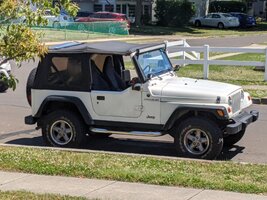Side marker lights work by voltage passing thru them. This is nothing new. This was the same problem on all the 70s 80s 90s GM cars and trucks. When the headlights are off, the side marker light is passed thru the ground for the turn signal. So when you turn the turn signal on it flashes with the front signal. When the headlights are on, its reversed which causes the side marker to stay on with the parking light but alternate with the turn signal. This reverses the polarity in the side marker light. Reversing the polarity is not something you can do with an LED. Its a diode, the polarity only works one way.
Super bright LEDS sells LEDs that will work in this situation in GM cars and trucks i have worked on. I have been doing LED bulbs for 20 years.
The Jeep TJs however, at least mine and my buddys 2000 will NOT work correctly even with the correct bulbs installed. They will light, but even with the LED flasher there will be flashing issues. The only way i have found to solve any of these problems is continue to run regular bulbs in the front turn signal/parking lights and leave LEDs for the side markers or vice versa.
There MUST be a load on the front turn signal circuit or there will be problems.




